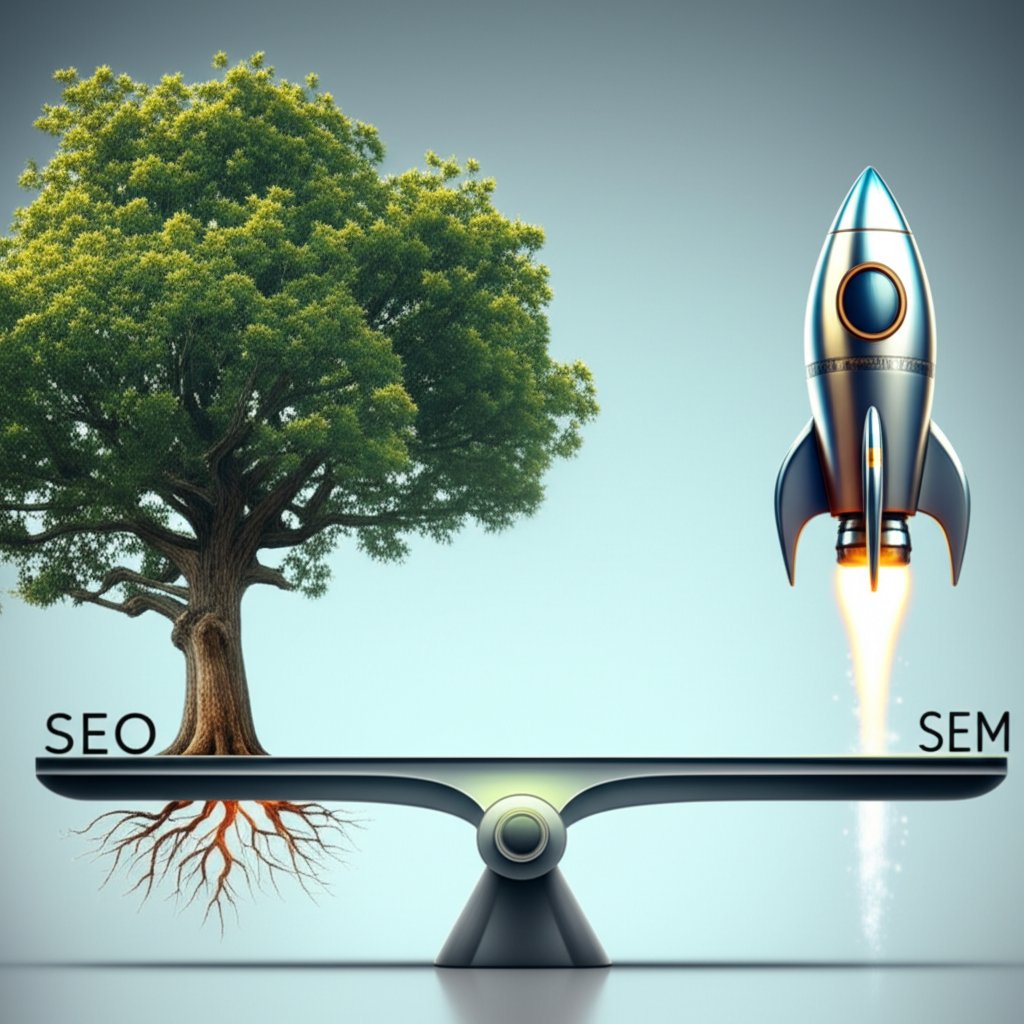TL;DR
A search marketing strategy is a comprehensive plan to increase a website’s visibility on search engine results pages (SERPs). It primarily involves two key disciplines: Search Engine Optimization (SEO), which focuses on earning unpaid, organic traffic, and Search Engine Marketing (SEM), which uses paid advertising (like pay-per-click) to appear in prominent positions. A successful strategy integrates both SEO and SEM to drive targeted traffic, generate leads, and achieve business goals.
Understanding Search Marketing: SEO vs. SEM
At its core, search marketing is the practice of gaining traffic and visibility from search engines through both paid and unpaid efforts. According to digital marketing resource WordStream, it’s a fundamental tactic for any business aiming to grow its online presence. The entire field is built on two powerful pillars: Search Engine Optimization (SEO) and Search Engine Marketing (SEM). While these terms are often used interchangeably, they represent distinct approaches that work best in tandem.
SEO is the long-term process of optimizing your website to rank higher in the organic, or unpaid, search results. This involves creating high-quality, relevant content, ensuring your site is technically sound, and building authority through backlinks from other reputable sites. The goal of SEO is to signal to search engines like Google that your website offers the most valuable and trustworthy answer to a user's query. Success in SEO builds sustainable, free traffic over time.
On the other hand, SEM almost exclusively refers to paid search advertising, also known as pay-per-click (PPC). With SEM, businesses bid on keywords to have their ads appear at the top of the SERPs. As noted in a guide by Adobe, this method provides immediate visibility and allows for precise targeting. When a user clicks the ad, the advertiser pays a fee. This approach is highly controllable and delivers fast results, making it ideal for specific campaigns, promotions, or reaching customers at the exact moment they are ready to buy.
While their methods differ, SEO and SEM are part of a unified strategy. Data from paid campaigns can inform your SEO keyword strategy, while a strong organic presence can improve your ad's Quality Score, potentially lowering your ad costs. Choosing which to prioritize depends on your goals, budget, and timeline.
SEO vs. SEM: A Quick Comparison
| Factor | SEO (Organic Search) | SEM (Paid Search) |
|---|---|---|
| Cost | No direct media cost, but requires investment in content, technical expertise, and time. | Direct cost for every click or impression (Pay-Per-Click). |
| Speed of Results | Takes time to see results (months to over a year). | Nearly immediate results once a campaign is live. |
| Longevity | Results are sustainable and can have a long-lasting impact. | Visibility stops as soon as you stop paying for ads. |
| Targeting | Targets broad topics and user intent through content. | Highly specific targeting based on keywords, demographics, location, and behavior. |
| Placement on SERP | Appears in the main organic results below the ads. | Appears at the very top and sometimes bottom of the SERP, marked as "Ad" or "Sponsored." |

The Core Pillars of a Winning Search Marketing Strategy
Building an effective search marketing strategy isn't about guesswork; it's a structured process founded on several key pillars. A successful plan moves from high-level objectives to granular execution, ensuring every action is purposeful and measurable. By focusing on these core components, you can create a cohesive strategy that aligns with your business objectives and delivers a strong return on investment.
The planning phase is crucial for laying a solid foundation. It involves understanding not just what you want to achieve, but who you need to reach and what your competitive landscape looks like. Each pillar builds on the last, creating a comprehensive roadmap for your search marketing efforts. Here are the essential steps to follow when building your strategy:
- Set Clear Goals: Your strategy must begin with well-defined objectives. Are you aiming to increase online sales by 15% this quarter? Generate 500 new leads per month? Or perhaps boost brand awareness in a new market? Your goals will dictate your key performance indicators (KPIs) and help you measure success.
- Conduct In-Depth Audience Research: You can't connect with your audience if you don't know who they are. Develop detailed buyer personas based on demographics, interests, pain points, and online behavior. Understanding your audience's needs and how they search for solutions is fundamental to crafting resonant messaging and selecting the right keywords.
- Perform Strategic Keyword Research: Keyword research is the bedrock of both SEO and SEM. As explained in a strategy guide by HawkSEM, the goal is to identify terms with a balance of high search volume and manageable competition. Use tools to find short-tail keywords (e.g., "running shoes") and long-tail keywords (e.g., "best trail running shoes for flat feet") that match different stages of the buyer's journey.
- Analyze Your Competitors: Investigate which competitors appear for your target keywords in both paid and organic results. Analyze their ad copy, landing pages, and the content they produce. This analysis will reveal opportunities to differentiate your brand and identify gaps in their strategy that you can exploit.
- Allocate Your Budget: Determine how you will divide your resources between SEO (content creation, tools, personnel) and SEM (ad spend). For your paid campaigns, set daily or monthly budgets and decide on a bidding strategy. Your budget should be flexible enough to scale up what's working and pull back on underperforming campaigns.
Executing Your Strategy: Key Paid and Organic Tactics
With a solid strategy in place, the focus shifts to execution. This is where you bring your plan to life through specific paid and organic tactics. A successful search marketing program requires diligent management of both SEM campaigns and ongoing SEO efforts. Each discipline has its own set of best practices that contribute to the overall goal of maximizing visibility and driving conversions.
SEM Campaign Tactics
Effective paid search management goes beyond simply bidding on keywords. It involves creating a highly organized campaign structure and continuously optimizing for performance. A well-structured account allows for better control, relevance, and ultimately, a higher return on ad spend (ROAS).
- Logical Campaign Structure: Organize your campaigns by product category, service line, or marketing objective. Within each campaign, create tight-knit ad groups where all keywords are highly relevant to the ad copy. This structure improves your Quality Score.
- Compelling Ad Copy: Write ads that address user pain points and include a clear call-to-action (CTA). Highlight unique selling propositions, such as free shipping, a special discount, or a key benefit, to stand out from competitors.
- Smart Bidding Strategies: Use a mix of manual and automated bidding strategies. Automated strategies like Target CPA (Cost Per Acquisition) or Target ROAS can leverage machine learning to optimize for conversions, but it's crucial to provide them with accurate conversion data.
- Landing Page Optimization: Your ad is only as good as the landing page it leads to. Ensure the page is mobile-friendly, loads quickly, and has a message that matches the ad. The user experience after the click is critical for converting visitors.
Fundamental SEO Tactics
SEO is a continuous effort to improve your site's relevance and authority. While it’s a long-term game, consistent application of fundamental tactics will steadily improve your organic rankings and traffic. These practices ensure your site is both user-friendly and easily understood by search engine crawlers.
- On-Page Optimization: Ensure every page on your site has a unique title tag, meta description, and headings (H1, H2, etc.) that include relevant keywords. Create descriptive URLs that are easy for both users and search engines to understand.
- High-Quality Content Creation: Regularly publish valuable, original content that addresses the questions and needs of your target audience. This builds topical authority and provides more opportunities to rank for relevant keywords.
- Technical SEO: Maintain a healthy technical foundation. This includes having a mobile-friendly design, fast page load speeds, a logical site structure, and an XML sitemap to help search engines crawl your site efficiently.
- Link Building: Earn backlinks from reputable and relevant websites. High-quality backlinks are a powerful signal to search engines that your site is a trusted authority in your industry.
Essential Tools for Your Search Marketing Arsenal
Executing a sophisticated search marketing strategy requires the right set of tools. These platforms provide the data, insights, and automation necessary to plan, manage, and optimize your campaigns effectively. From discovering what your audience is searching for to measuring the return on your investment, a well-rounded tool stack is essential for staying competitive.
Different tools serve different purposes across the strategy lifecycle. For planning, you need robust research tools. For execution, you need powerful management platforms. And for optimization, you need precise analytics. Many tools offer free versions or trials, allowing you to build a foundational toolkit without a significant initial investment.
Here are the key categories of tools every search marketer should have:
- Keyword Research Tools: These are fundamental for both SEO and SEM. They help you discover relevant keywords, analyze their search volume, and assess their competition level. Examples include Google Keyword Planner, Ahrefs, and SEMrush.
- Analytics Platforms: To measure performance, you need a powerful analytics platform. These tools track website traffic, user behavior, conversion rates, and other key metrics. Google Analytics is the industry standard and a must-have for any marketer.
- Ad Management Platforms: These are the dashboards where you build, manage, and monitor your paid search campaigns. The primary platforms are Google Ads and Microsoft Advertising, which provide detailed controls for bidding, targeting, and reporting.
- Competitor Analysis Tools: These tools give you insight into your competitors' strategies. You can see the keywords they are bidding on, their estimated ad spend, and their top-performing ad copy. Platforms like SpyFu and SEMrush are excellent for this.
- Content Creation & Optimization Tools: Scaling your content efforts is crucial for SEO. For marketers and creators looking to streamline their workflow, platforms like BlogSpark offer an AI-powered solution to generate engaging, SEO-optimized articles, helping to scale output and maintain quality.

Frequently Asked Questions
1. What is an example of search marketing?
A classic example of search marketing is a local bakery using Google Ads. The bakery bids on the keyword "cupcakes near me." When a user in their city searches for that term, the bakery's ad appears at the top of the search results page. The ad might offer a discount or highlight their unique flavors. When the user clicks the ad, they are taken to the bakery's website to place an order, and the bakery pays a small fee to Google for that click. This is a direct application of SEM to drive immediate, purchase-intent traffic.
2. What is search marketing?
Search marketing is a broad digital marketing strategy aimed at improving a website's visibility in search engine results pages (SERPs). As explained in a Coursera article on the topic, it encompasses two main disciplines: Search Engine Optimization (SEO), the practice of improving organic rankings through unpaid methods, and Search Engine Marketing (SEM), which involves using paid advertising (like pay-per-click ads) to secure prominent placement. The ultimate goal is to attract more qualified traffic to a website by appearing as a relevant result for user queries.




